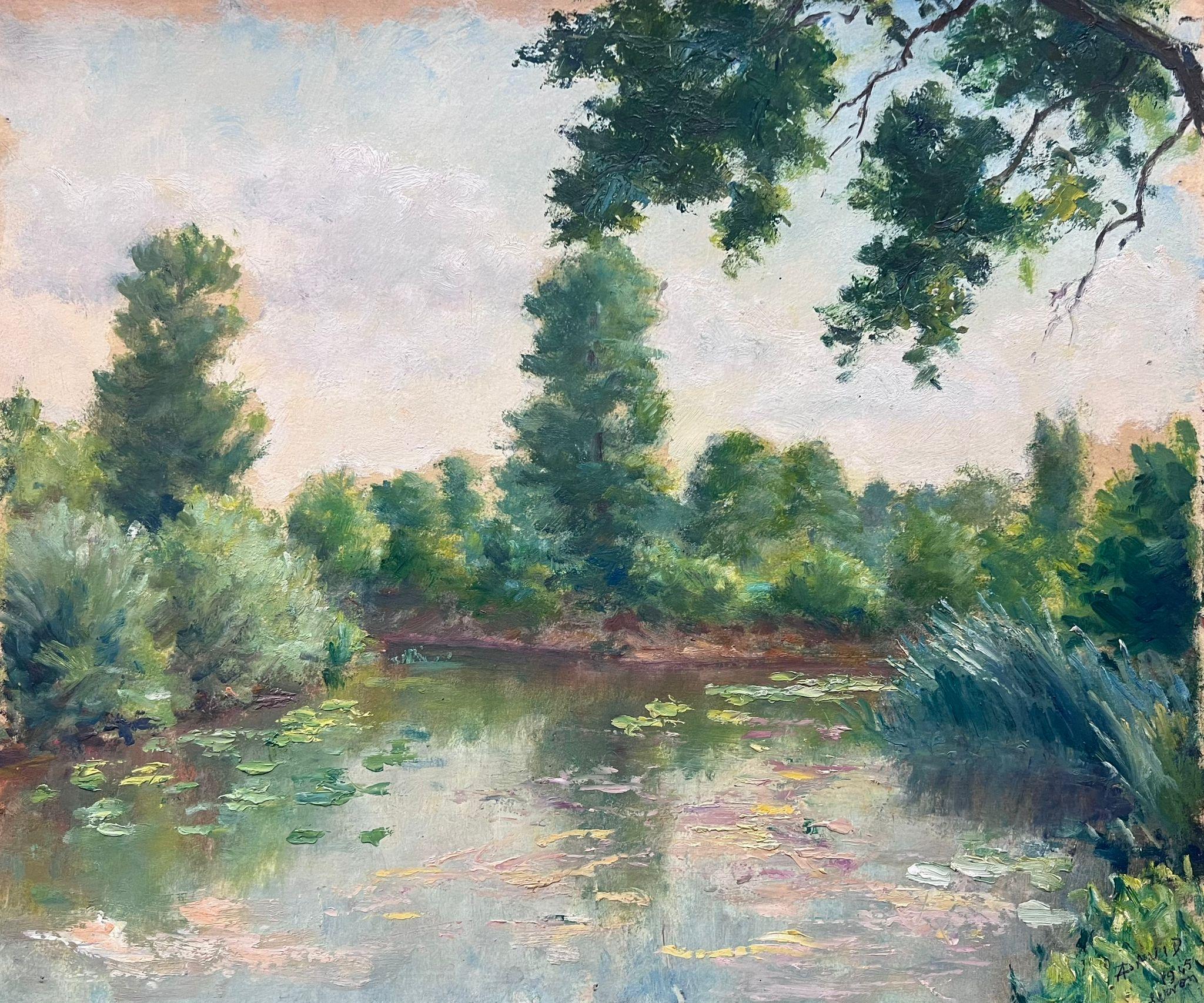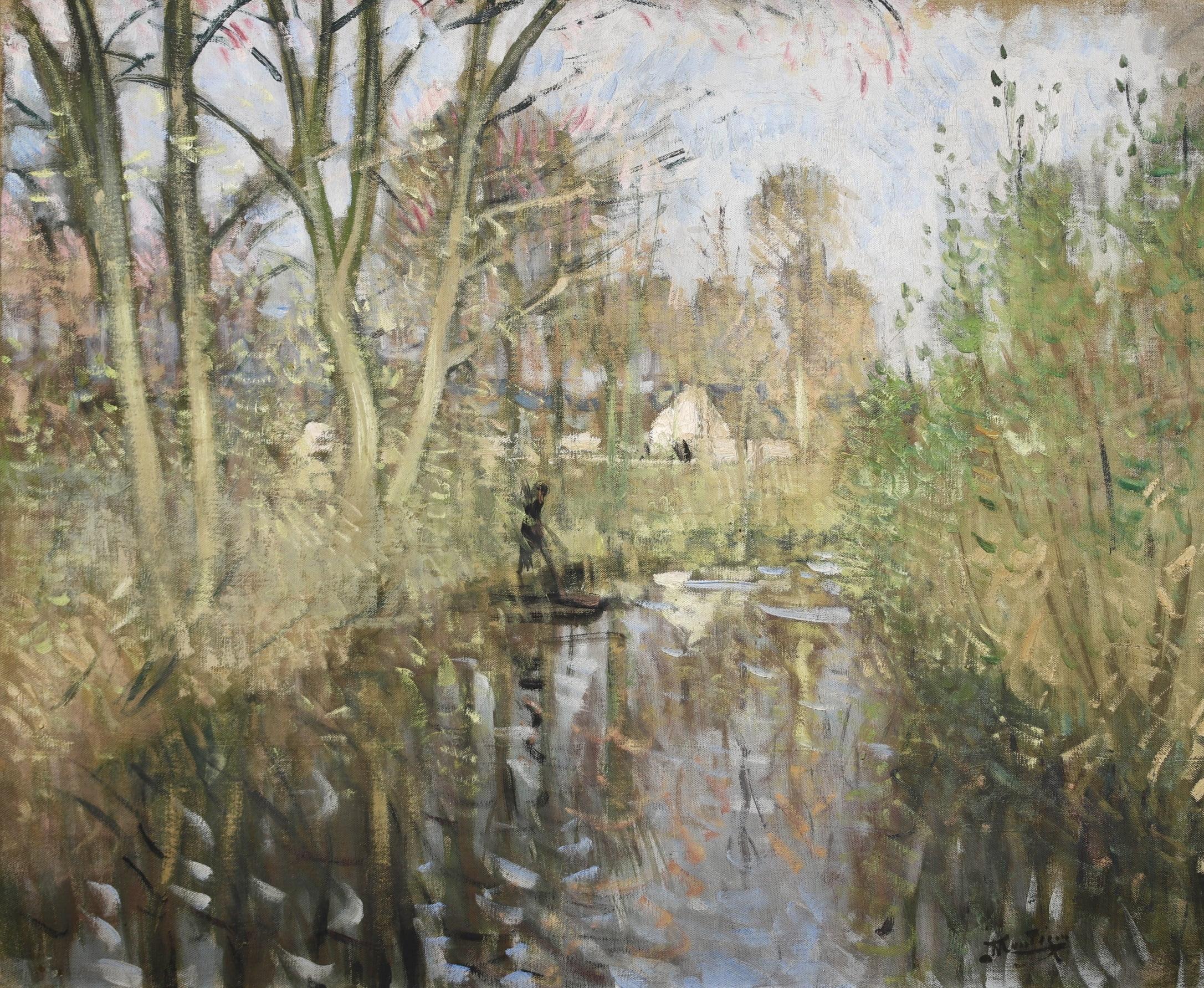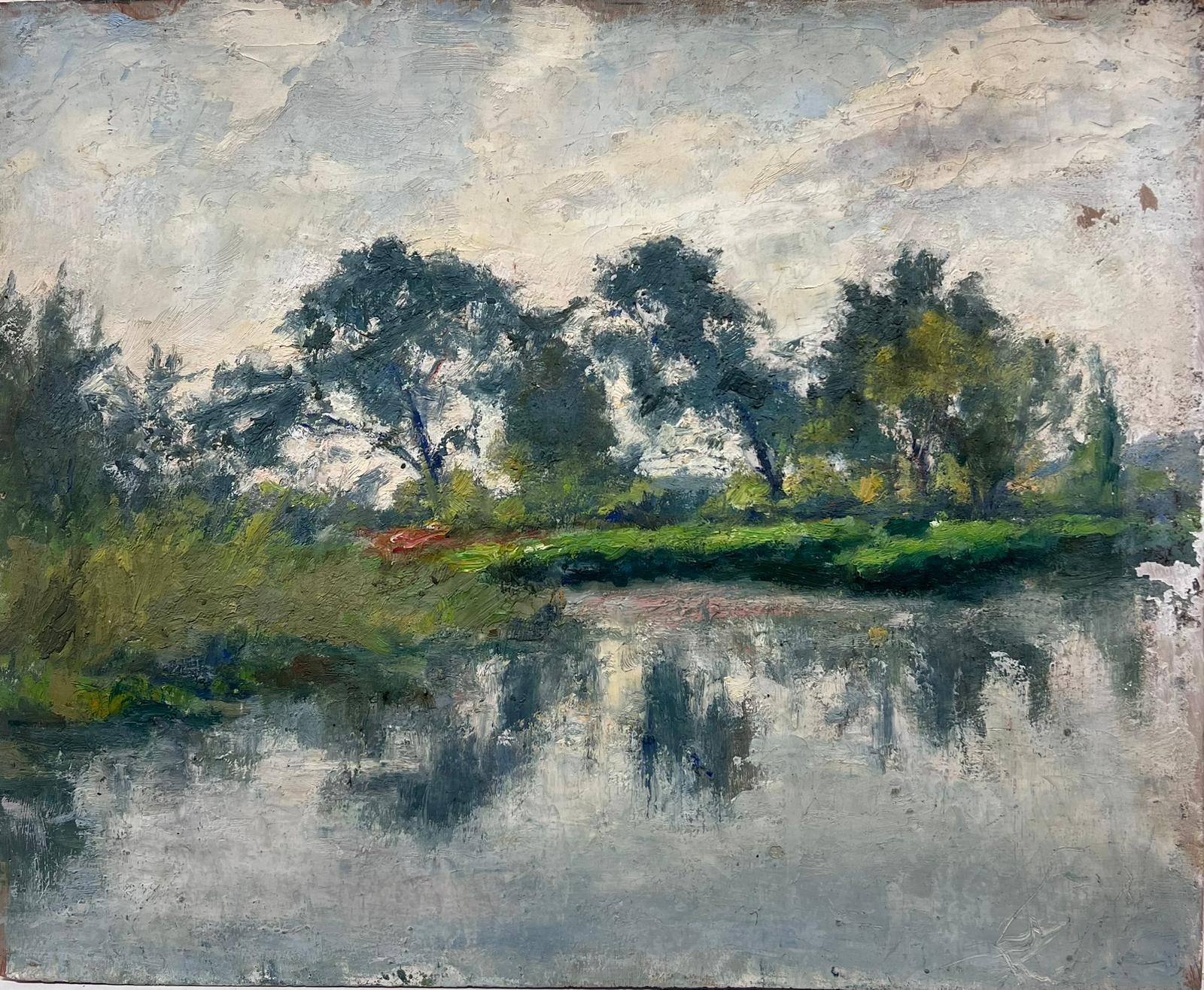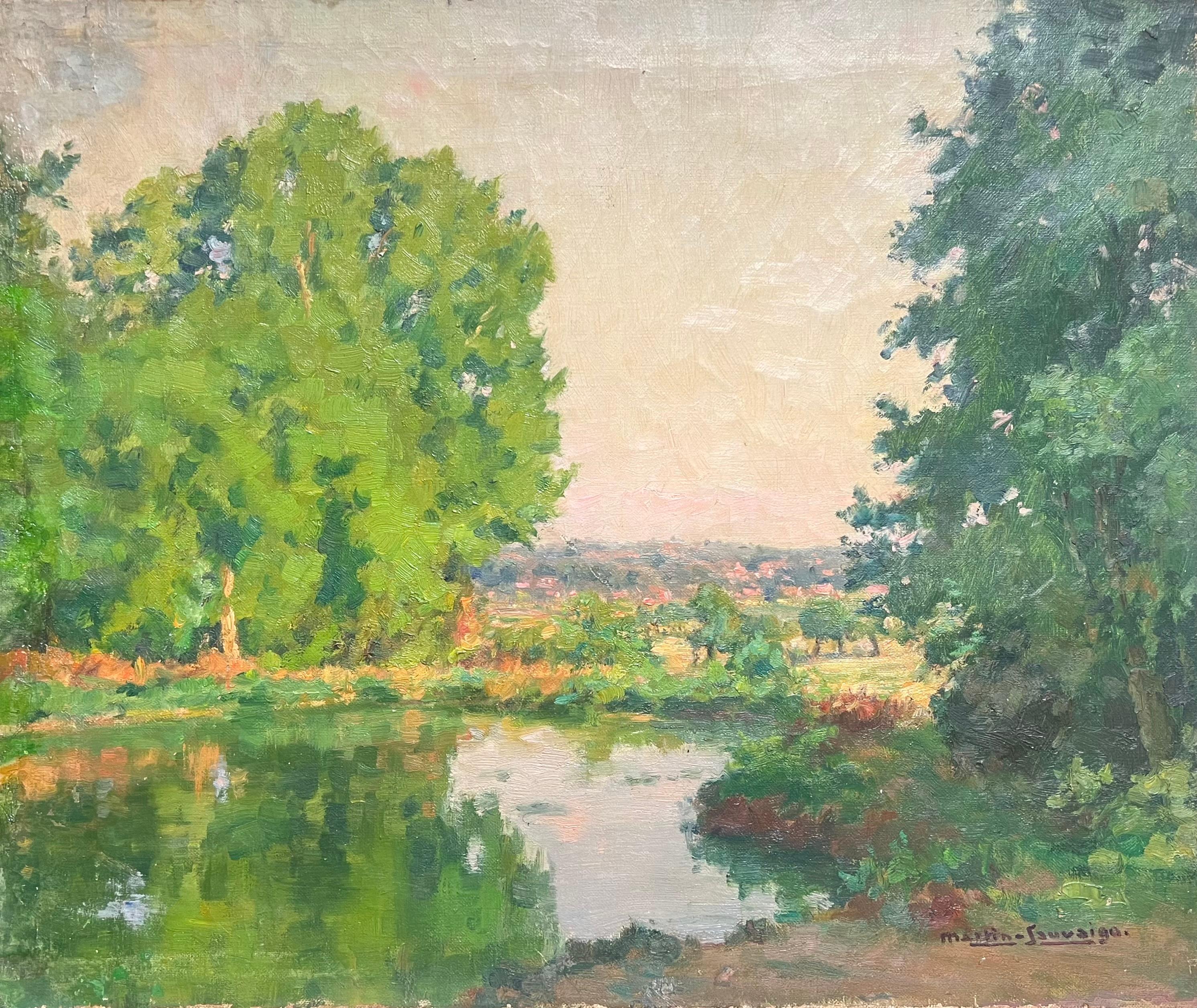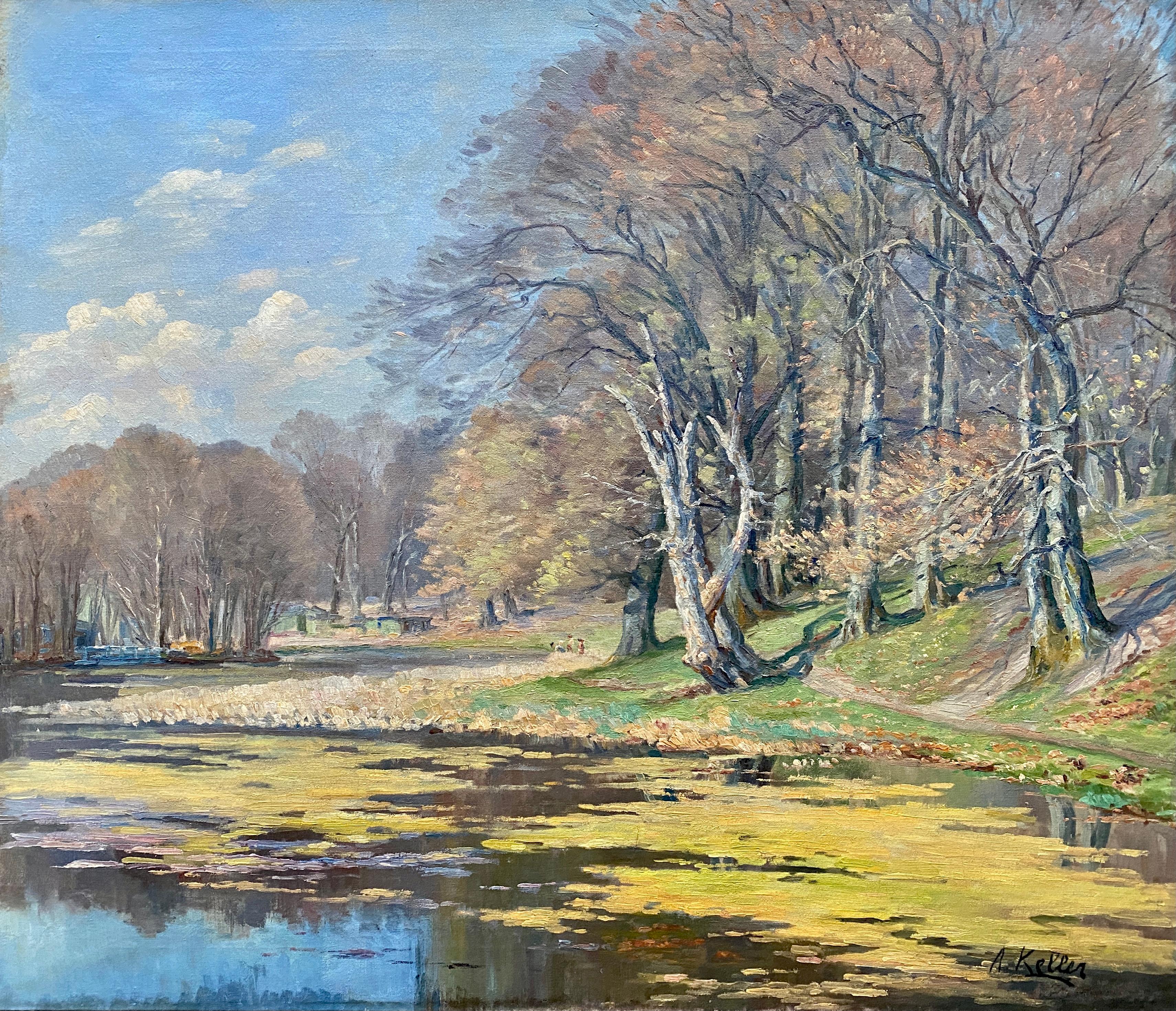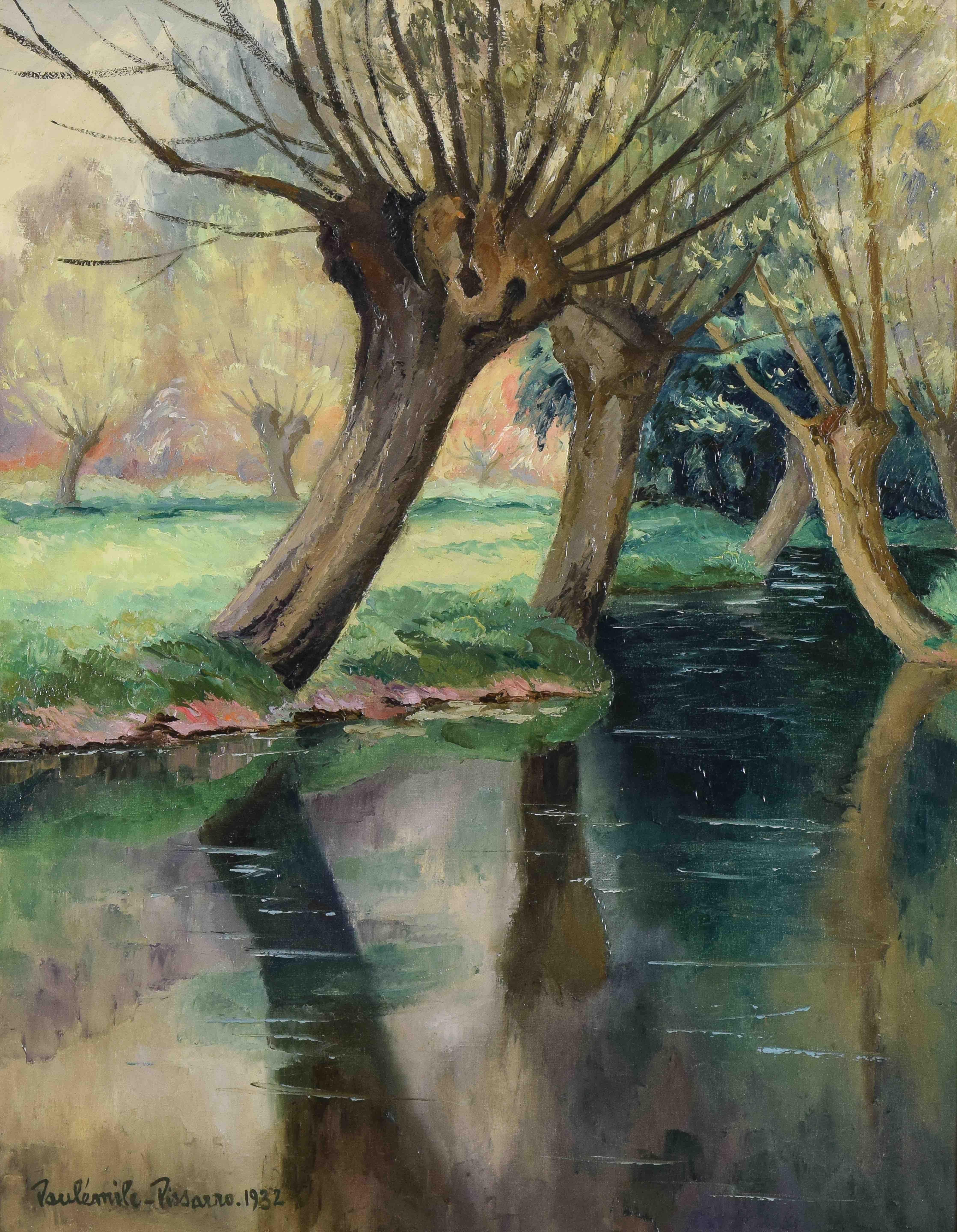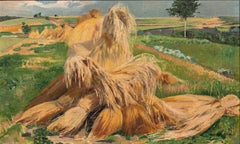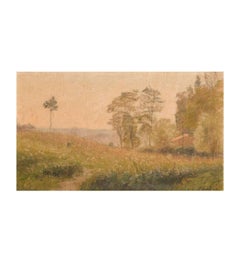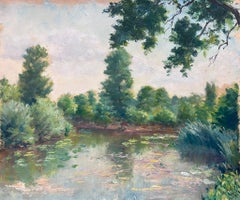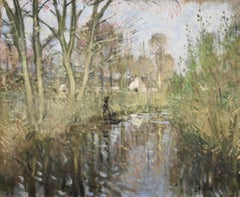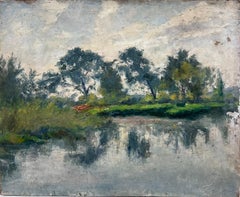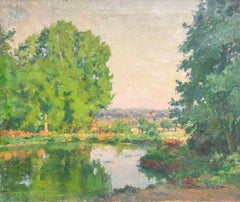Items Similar to Paul-Édouard Crébassa (1864-1912) - River with water lillies
Want more images or videos?
Request additional images or videos from the seller
1 of 14
Paul-Édouard CrébassaPaul-Édouard Crébassa (1864-1912) - River with water lillies 19th century
19th century
$2,852.70
£2,124.37
€2,400
CA$3,938.54
A$4,366.46
CHF 2,294.74
MX$53,438.29
NOK 28,659.02
SEK 26,899.36
DKK 18,272.80
About the Item
Paul-Édouard Crébassa’s painting is a beautiful example of post-impressionist art, showcasing his ability to blend detailed observation with expressive techniques to capture the ephemeral beauty of nature. The painting invites viewers to appreciate the quiet, reflective moments found in natural settings.
The painting captures a serene natural scene, a slow-moving stream surrounded by lush greenery. The composition is balanced, with trees leaning inwards towards the centre, creating a natural frame for the water body. The foreground features the reflective surface of the water, adorned with floating lily pads. The reflections of trees and light on the water add depth and complexity to the composition. The background fades into a bright, sunlit landscape, suggesting an open field or a continuation of the forest. The interplay between light and shadow creates a dynamic yet tranquil atmosphere.
Crébassa employs a rich, natural palette dominated by greens, yellows, and browns. The use of vibrant colors in the foliage contrasts with the softer, more muted tones of the reflections in the water. The painting features a masterful use of light, with sunlight filtering through the trees, casting dappled shadows on the ground and water. This effect adds realism and enhances the peaceful mood of the scene. The reflection of trees in the water is depicted with varying hues and shades, capturing the movement and distortion caused by the water’s surface. This technique highlights Crébassa's skill in portraying natural elements authentically.
Crébassa’s brushwork is fluid and expressive, particularly in the depiction of the water and foliage. The strokes are both deliberate and loose, allowing for a realistic yet impressionistic rendering of the scene. The texture in the painting is achieved through layered brushstrokes, giving depth to the trees and foliage while maintaining a smooth, reflective quality in the water. This textural variation adds to the tactile sense of the scene. The painting shows clear influences of the Impressionist movement, particularly in its focus on capturing light and atmosphere. The loose brushstrokes and vibrant colour palette are characteristic of this style.
The overall mood of the painting is one of tranquillity and serenity. The calm water and the gentle interplay of light and shadow evoke a peaceful, almost meditative state. Crébassa effectively captures the beauty of a natural, untouched landscape. The detailed rendering of the flora and the reflective water surface emphasizes the harmony and simplicity of nature.
The painting likely a scene familiar to Crébassa, possibly from the French countryside, reflecting his connection to the natural landscapes of his homeland.
This painting is dedicated to Louis Nicolas Matout (1811-1888), who was a renowned French painter and muralist, known primarily for his cityscapes, genre scenes, and historical murals, as is evidenced by the inscription. "Au grand pêcheur Louis Matout mon ami." This highlights the mutual respect and camaraderie shared among artists of that period.
Biography of Paul-Édouard Crébassa
Paul-Édouard Crébassa was born on April 4, 1864, in Graissessac, Hérault, France. His artistic journey began in his hometown before he moved to Paris to further his education and career. Paris, being the cultural heart of France, provided Crébassa with ample opportunities to develop his skills and gain exposure. He was a versatile artist, known for his work as a painter, lithographer, and illustrator. His works are noted for their post-impressionist style, characterized by vivid colors and expressive brushwork. Crébassa's subjects ranged from urban landscapes and café scenes to more intimate studies of human figures and daily life.
Some of his notable works include "Café de nuit" (1897), "Nu au bord d'une rivière," and "La Rixe." He also created a series of lithographs such as "Les femmes à l'absinthe" (1894) and "Fumeuse ou Intimité" (1895), which are housed in prestigious institutions like the National Gallery of Art in Washington, the Rijksmuseum in Amsterdam, and the Detroit Institute of Arts
Crébassa exhibited his works in various important venues throughout his career. His works were featured in both national and international exhibitions, earning him recognition and acclaim. He was active in the Parisian art scene, participating in exhibitions that showcased his lithographs and paintings, reflecting the vibrant life of the city and its inhabitants. Paul-Édouard Crébassa passed away on May 6, 1912, in Paris. Despite his relatively short life, his contributions to post-impressionist art were significant. His works continue to be appreciated for their dynamic compositions and vibrant use of color. Crébassa's art offers a glimpse into the cultural and social milieu of late 19th and early 20th century France.
Crébassa's works are part of several notable collections. The National Gallery of Art, the Rijksmuseum, and the Detroit Institute of Arts hold some of his most important lithographs, ensuring that his artistic legacy endures. His works remain a subject of interest for collectors and art historians alike, reflecting the enduring appeal of his artistic vision.
- Creator:Paul-Édouard Crébassa (1864 - 1912, French)
- Creation Year:19th century
- Dimensions:Height: 16.54 in (42.02 cm)Width: 19.69 in (50.02 cm)Depth: 1.57 in (3.99 cm)
- Medium:
- Period:
- Condition:
- Gallery Location:Gent, BE
- Reference Number:1stDibs: LU2140214991992
About the Seller
5.0
Vetted Professional Seller
Every seller passes strict standards for authenticity and reliability
Established in 2018
1stDibs seller since 2022
5 sales on 1stDibs
Typical response time: 2 hours
- ShippingRetrieving quote...Shipping from: Gent, Belgium
- Return Policy
Authenticity Guarantee
In the unlikely event there’s an issue with an item’s authenticity, contact us within 1 year for a full refund. DetailsMoney-Back Guarantee
If your item is not as described, is damaged in transit, or does not arrive, contact us within 7 days for a full refund. Details24-Hour Cancellation
You have a 24-hour grace period in which to reconsider your purchase, with no questions asked.Vetted Professional Sellers
Our world-class sellers must adhere to strict standards for service and quality, maintaining the integrity of our listings.Price-Match Guarantee
If you find that a seller listed the same item for a lower price elsewhere, we’ll match it.Trusted Global Delivery
Our best-in-class carrier network provides specialized shipping options worldwide, including custom delivery.More From This Seller
View AllLandscape at Nafraiture by Léon Frederic (1856 - 1940)
By Léon Frédéric
Located in Gent, VOV
Léon Frédéric was one of the greatest representatives of Belgian symbolism and realism. He was ennobled as a baron in 1929 by King Albert I.
Discove...
Category
20th Century Landscape Paintings
Materials
Oil
Arsene Chabanian (1864-1949) the old watermill
Located in Gent, VOV
This fine pastel depicts a serene landscape featuring a flowing river, a bridge, and a building on the right side. The details in the painting, such as the texture of the foliage, th...
Category
20th Century Landscape Paintings
Materials
Pastel
French landscape painting by Paul Sébilleau (1847-1907), oil on canvas+ "Spring
Located in Gent, VOV
Serene beauty of the French countryside with this exquisite oil on canvas by Paul Sébilleau (1847-1907), titled "Spring Evening May 1901." This captivating french landscape painting ...
Category
Early 20th Century Realist Landscape Paintings
Materials
Oil
Sébilleau Paul (1847-1907), Oil on canvas+ Spring evening May 1901
Located in Gent, VOV
A captivating evening scene by Paul Sébilleau, renowned French painter. This landscape on canvas, titled "Spring Evening, May 1901," showcases Sébilleau's mastery of light and color....
Category
Early 20th Century Realist Landscape Paintings
Materials
Oil
Vue d'un sous bois, tableau daté 1901, huile sur toile de Feodor Petrovich Rizni
Located in Gent, VOV
View of an undergrowth, 1901
Dimensions: 49 x 80 cm (unframed)
Oil on canvas
Signed lower left and dated
Fedor Petrovich Riznichenko - Russian and Ukrainian landscape painter, was ...
Category
20th Century Landscape Paintings
Materials
Canvas, Oil
View of Afsnee by Fritz Van Loo (1871-1957)
Located in Gent, VOV
Fritz Van Loo's "View of Afsnee" is a beautiful example of post-impressionist landscape painting, deeply influenced by the luminism of Emile Claus. The painting captures the serene b...
Category
20th Century Landscape Paintings
Materials
Oil
You May Also Like
Mid 20th Century 1950's French Post-Impressionist Oil Waterlily Pond Summer
Located in Cirencester, Gloucestershire
The Waterlily Pond
signed by Regine David (female French artist, 1910-2018)
dated 1945
oil painting on board, unframed
measures: 13 x 16 inches
condition: the painting is in very sou...
Category
Mid-20th Century Post-Impressionist Landscape Paintings
Materials
Oil
La Chalandiere a Briere - Impressionist River Landscape Oil by Pierre Montezin
By Pierre Eugène Montezin
Located in Marlow, Buckinghamshire
Signed and titled oil on canvas riverscape by sought after French impressionist painter Pierre Eugene Montezin. The work depicts a view of a river in autumn. The trees that line the ...
Category
1910s Impressionist Figurative Paintings
Materials
Canvas, Oil
Fine Antique French Impressionist Signed Oil Painting Beautiful River Landscape
Located in Cirencester, Gloucestershire
River Landscape
by Charles Martin-Sauvaigo (French 1881-1970) * see notes below
French Impressionist painter
oil painting on wooden panel
unframed
size: 13 x 16 inches
condition: ve...
Category
Early 20th Century Impressionist Landscape Paintings
Materials
Oil
Antique French Impressionist Oil Tranquil Riverbank Scene Luminous Landscape
Located in Cirencester, Gloucestershire
Tranquil Riverbank Scene
first half 20th century
Charles Marvin - Sauvaigo ( 1881 - 1970)
signed oil on canvas, framed
Canvas: 18 x 21.5 inches
Provenance: private collection, Franc...
Category
Mid-20th Century Impressionist Landscape Paintings
Materials
Oil
Along the Lake, Adolphe Keller, Brussels 1880 – 1968, Belgian Painter, Signed
By Adolphe Keller
Located in Knokke, BE
Along the Lake
Keller Adolphe
Brussels 1880 – 1968
Belgian Painter
Signature: Signed bottom right
Medium: Oil on canvas
Dimensions: Image size 51 x 61 cm
Biography: Keller Adolphe was born on June 21 in 1880 in Brussels. He was a post-Impressionist painter of genre scenes and flower still lifes, but with a preference for landscapes. He was also draughtsman, watercolourist and pastelist.
He studied at the Academies of Fine Arts in Brussels and Sint-Joost-Ten-Node with master teachers P. Braeke and H. Ottevaere.
In 1910 he took part in the great Brussels Exhibition.
He often paints around the Red Cloister (Auderghem) on the edge of the Sonian Forest, where he settled in 1934. He also painted in the South of France, in Saint-Tropez.
Keller was a chairman of the Alfred Bastien...
Category
20th Century Impressionist Landscape Paintings
Materials
Canvas, Oil
La Rivière by PAULÉMILE PISSARRO - Post Impressionist Landscape Painting, River
By Paul Emile Pissarro
Located in London, GB
*UK BUYERS WILL PAY AN ADDITIONAL 20% VAT ON TOP OF THE ABOVE PRICE
La Rivière (The River) by PAULÉMILE PISSARRO (1884-1972)
Oil on canvas
92 x 73 cm (36 1⁄4 x 28 3⁄4 inches)
Signed...
Category
1930s Post-Impressionist Landscape Paintings
Materials
Oil, Canvas
More Ways To Browse
Lily Pad Painting
Amsterdam Cityscape Paintings
Antique Water Filter
Lily Pad Oil Paintings
Le Pecheur
French Absinthe
Lil Painting Landscape
Bords De Riviere
Oil Painting On Cardboard Antique
Canal French Painting
Pyramid Oil Painting
19th Century Farm Paintings
Adrian Artist
Boat Painting Impressionist Large
Duke Of Windsor
Oil Portrait Francis
Rain Clouds
Thomas Hand Oil Painting
